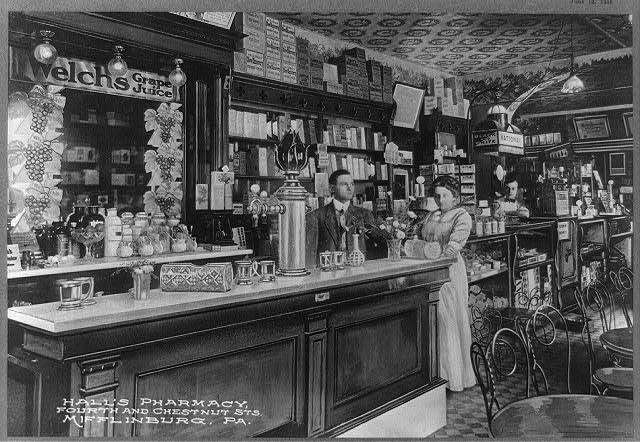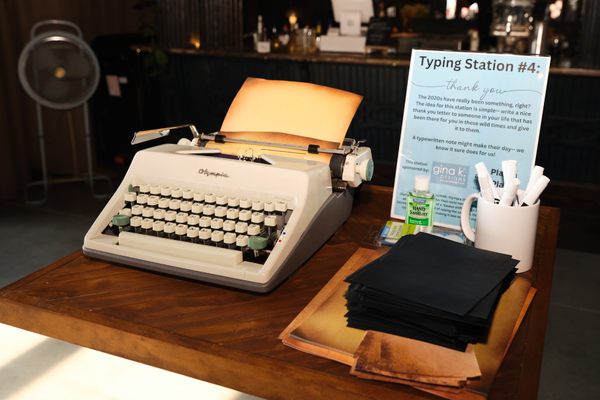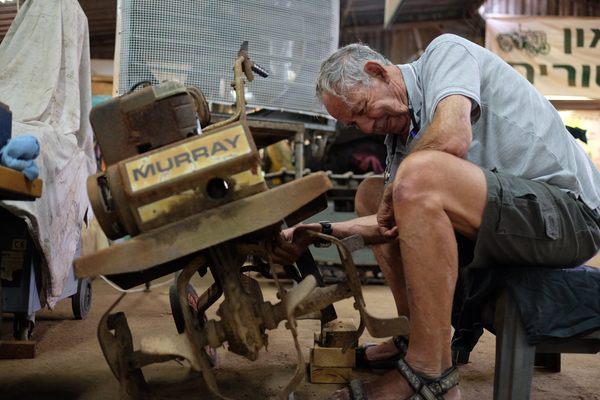Victorians Drank Soda Out Of Monstrous Gilded Machines
The 19th century saw a soda fountain arms race.
A typically opulent 1880s soda fountain, in a drugstore in British Columbia. (Photo: Bettman/Getty Images)
On a hot day, a cold soda can feel downright luxurious. Pop the tab, tip your head back, and the sweet liquid transports you somewhere a little cooler; a little slower.
The presentation, though, leaves something to be desired. Sure, an aluminum can works fine, but think about it—wouldn’t that ginger ale have tasted just a little better if it had come fizzing out of a bright copper spigot? Perhaps one connected to a six-foot-tall, marble-and-glass fountain, decorated top to bottom with taxidermied animal heads and Greek statuary?
In the golden age of soda—from the 1830s all the way through the 1920s—such dispensaries were de rigueur. Parched customers got their fixes from glitzy, monstrous machines, designed to make refreshment a truly multi-sensory experience.

The “Mammoth Soda Fountain,” at the 1876 Centennial Exposition, was about 30 feet tall. (Image: New York Public Library/Public Domain)
At first, soda machinery was a matter of necessity. 19th-century consumers were enthralled by the supposed healing properties of fizzy water, but for druggists to meet this demand, they had to find a way to put the bubbles in. A few chemists stepped forward with ideas, but the first to truly crack the case was John Matthews, a British expat who came to New York to seek his fortune in the burgeoning soda water industry. Matthews invented an easily-installable carbonation machine, which made brewing and serving fizzy drinks easy. Soon, his models could be found across the city.
Around the same time, thanks to the introduction of syrups, fruit juices, essential oils, and cream, mineral water was transforming from medicine to dessert. All of a sudden, a plain old nozzle wouldn’t cut it. ”More dramatic, alluring forms were needed,” writes Anne Cooper Funderberg in Sundae Best: A History of Soda Fountains—“eye-catching, seductive forms that promised the customer a hedonistic treat.”

“The Corinth,” one of many offerings in John Matthews’s 1882 soda fountain catalog. (Photo: Public Domain)
The first person to rise to this occasion was G. D. Dows, a design-minded drugstore clerk from Lowell, Massachusetts. Tired of spending his shifts laboriously shaving ice by hand, Dows cooked up a crank-based apparatus that did it for him. He added more gizmos: measuring decanters, a soda-water tube, and eight silver-plated syrup spigots, each with a tiny eagle perched atop it, wings spread wide. Then, he covered the whole thing in white marble from a nearby tombstone cutter’s shop.
Soon, Dows was slinging soda fountains instead of soda: “They became so popular that he could not supply the demand for them,” reported Chemist and Druggist 20 years later.
Thus begun, essentially, a soda fountain arms race. Inventors sought the perfect combo—the most efficient technology in the most ostentatious package. The “Monitor Crystal Spa,” by William Gee, had a spinning carousel for syrups, and was topped by a tasteful nude statue. J.G. Low’s massive three-sided fountain featured a tile mosaic depicting a kind of soda origin myth, in which dancing angels crushed fruits into a “Fountain of Thirst.” One well-worn story had an old woman mistaking a soda fountain for a war monument, and the many sparkling water types it advertised—Saratoga, Deep Rock, Washington—for battles.

Another of Charles Lippincott’s fountains from the 1876 Centennial Exposition—with taxidermed deer heads, a Greek statuette, and a bouquet on top—as drawn in James Dabney McCabe’s Illustrated History of the Centennial Exposition. (Image: James Dabney McCabe/Public Domain)
The most prolific inventor was still Matthews, eventually known as “the Neptune of the Trade.” His creations, collected in this illustrated catalog, appear almost sentient, and are futuristic and retro all at once. The “Frost King” featured gas jets (“for illumination at night”), six different kinds of marble, a “pyramid superstructure,” and 60 embedded jewels.
The “El Dorado,” with its marbled roof and all-seeing eye motif, looks like an Illuminati pinball machine. Still more innovations never quite caught on—dig into 19th-century patents and you find soda dollhouses, actual fountains, and iceberg-shaped nozzle covers which “produce Frost on their Surfaces.”
Perhaps the height of soda opulence came with the nation’s Centennial Exposition, held in Philadelphia in 1876. In a rare show of collaboration, rival fountaineers James Tufts and Charles Lippincott purchased the dispensary rights for the entire show, and collaborated on about a dozen massive fountains: the quaint Hartford, the intimidating Saxon. Outside one exhibit hall, in the hot sun, stood the largest of all—a three-story behemoth festooned with ferns, chandeliers, elaborate murals, and seventy-six syrup spigots. People loved it. “It is the largest fountain in the world,” summed up one attendee, “and is by far the handsomest.”

Hall’s Pharmacy in Mifflinburg, PA, sporting a tulip-topped soda fountain, curlicue chairs, marble counters, and fancy mirrored walls. (Photo: Library of Congress/LC-USZ62-11379)
Businesses snapped up smaller versions of these crowd favorites, and once inside, these soda fountains didn’t keep to themselves. In many cases, their new aesthetic bubbled up over the counters and spilled into the rest of the establishment. “These marble fountains changed the ambience of the entire drugstore,” writes Fundenberg. “Many pharmacists updated their decor by removing traditional curiosities, like ugly snakes or [preserved] organs.” It was a shiny new age of drugstore decoration: chandeliers, Tiffany lamps, mirrored walls, even musical automatons.
By the end of the 19th century, most major cities boasted hundreds of fountains, and even frontier towns had one or two. ’You can sit and while the hours away consuming inordinate quantities of iced soft drinks,” wrote one Londoner on a visit to New York, “and listening to a band for a nickel in the slot machine, not infrequently a horrible but ingenious German contrivance of a fiddle played by electricity.”

A more restrained model, now on display at the New Orleans Pharmacy Museum. (Photo: Ryan Lackey/CC BY 2.0)
But all fads, even the stickiest, must fade. Slowly, carbonation machinery got smaller, reducing the need for a full-on chemistry setup. ”The wall temples began to disappear in favor of the modern counter, with the apparatus hidden inside of it,” writes Joseph L. Morrison in a 1962 eulogy to the trade. The now-empty space was filled with mirrors, and clever stacks of glasses. Slick had replaced baroque.
It’s enough to make you look forlornly at your SodaStream. But if you want to tap into the true legacy of soda, there is one place you can still go: John Matthews’s grave. Not unlike his fountains, Matthews’s monument, in Brooklyn’s Green-Wood Cemetery, features red granite columns, sculpted animals, and carved scenes involving the great man’s various inventions—as well as a statue of Matthews himself, lying prone, perhaps from a brain-freeze.
On rainy days, the gargoyles turn into waterspouts, pouring one out for the lost age of the soda fountain.


















Follow us on Twitter to get the latest on the world's hidden wonders.
Like us on Facebook to get the latest on the world's hidden wonders.
Follow us on Twitter Like us on Facebook